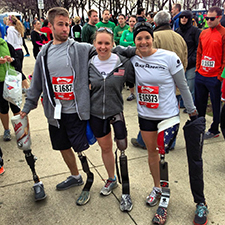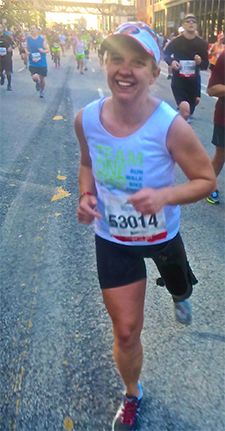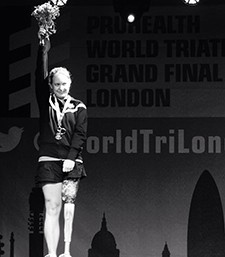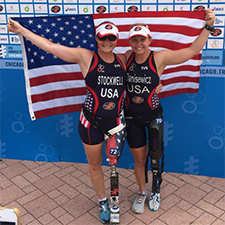You Should Know Hailey
It was a lump on her tibia, just below her left knee. She didn’t think anything of it. She was an athlete. Bumps and bruises were par for the course. But when the pain and swelling didn’t go away, her mom called the doctor. It was the first day of track season. Hailey never made it to practice. In fact, she would never run on her own two legs again.
*****
I first met Hailey in 2012 at a book signing for The Lola Papers in Chicago. We were at a local triathlon store. I was standing behind a folding table unpacking books when she walked in, pushing her bike through the door and throwing her sunglasses to the top of her head. She was clad in cycling duds and her shoes clicked against the hardwood floors.
“Hi! I’m Hailey! I work here,” she said as she leaned her bike against her hip and held out her hand.
“Hey! I’m Amy.”
The first thing I noticed was that her face was fresh and she was barely sweating even though she had spent the last hour or so pedaling across the city in one-hundred-degree temperatures. (An earthly impossibility I still can’t figure out.)  The carbon and steel apparatus extending from her left thigh to where the rest of her leg should have been was merely an afterthought.
The carbon and steel apparatus extending from her left thigh to where the rest of her leg should have been was merely an afterthought.
We talked for a few minutes before she made her way to the back of the store. As it turned out, she was training for the Paratriathlon World Championship in Auckland, New Zealand. She was relatively new to triathlon, having picked up the sport the summer before. The dichotomy of budding passion and quiet confidence in her voice made it difficult to discern her age. She looked young. She spoke with an old soul.
“How old are you?” I asked.
“Twenty-one.”
I asked more questions. Hailey answered. Two years later, Hailey’s story still resonates with me.
*****
It was a lump on her tibia, just below her left knee. Sure, it hurt, but she didn’t think much of it. She was an athlete who starred on her basketball and volleyball teams at school. She was as fearless and aggressive as anyone in her sixth grade class. Bumps and bruises were par for the course. But when the pain and swelling persisted for several weeks, her mom scheduled an appointment with the pediatrician. Track season was about to start. She needed to be healthy.
On the day of the appointment, her parents picked her up early from school. The first track practice of the season was that afternoon, and all she could think about was getting back in time to run sprints with her teammates. She had spent the past three months running on her own in preparation. Forget the doctor’s appointment. She had to be back by 3:00pm.
She wasn’t.
The painful, peach-sized bump on her leg was a cancerous tumor. Hailey was diagnosed with osteosarcoma. She started chemo two days later. Her doctors placed her on crutches as a precautionary measure. They told her not to do anything active that could further damage the bone. Specifically, they told her not to run.
Hailey received twelve months of chemo and underwent multiple surgeries, including a full knee replacement. Doctors removed the tumor and part of her tibia, replacing it with a cadaver bone. But Hailey’s recovery from the surgeries didn’t go as planned. Scar tissue built up around her knee, and she lost all mobility in her left leg. Further surgeries, nerve replacement, and physical therapy failed to restore its function. One year after her last chemo treatment, she still couldn’t walk without pain or crutches.
The following summer, Hailey visited a camp where she saw people with prosthetics running, walking, and playing sports—pain-free. "They were doing all the things I loved to do and couldn't because of my leg," she says. The decision was a no-brainer. Hailey told her parents it was time to amputate her leg. She was fourteen.
“It was a quality of life decision. It was completely my choice. I told my parents it was what I wanted to do. At first they were a little shocked, but they understood.” She pauses. “I tell people that I chose function and practicality over vanity. When you put it that way, it just kinda makes sense."
Still, the decision had its own set of ramifications. Adjusting to life as an amputee isn’t easy. The emotional toll was heavy. For six years, Hailey questioned her identity. Sports had always defined her. She was active and adventurous. Suddenly, as a high school freshman, she found herself no longer the athlete, but a cancer survivor and amputee.
“Although I was very active in sports growing up, I hadn’t really gotten involved in the disabled sports world since losing my leg because I didn’t consider myself to be disabled. I desperately wanted to get back into athletics, but I held back.”
But in 2011, as a student at Northwestern, Hailey began looking into summer internship opportunities. She stumbled upon the Great Lakes Adaptive Sports Association (GLASA), an organization that provides opportunities in sport for kids with physical impairments. Hailey applied for an interview and met with the program’s supervisors, Tom and Keri. Keri had just started a paratriathlon club called dare2tri. She offered Hailey a position in the organization under one condition: she complete a triathlon. Hailey agreed.
“My M.O. is signing up for things that I’m terribly unprepared for,” she laughs. “But I think there is great benefit in doing that. For everybody, the mind is the greatest obstacle to overcome. If you don’t have time to be scared for the thing you signed up for, then you’re not going to be scared.”
At the recommendation of Tom and Keri, Hailey made an appointment with David Rotter of Scheck & Siress Prosthetics, a prosthetist who specializes in fitting amputees for sports. It was there that she met Melissa Stockwell, an above-knee amputee, like Hailey, who lost her leg while serving in Iraq. Melissa also happened to be the world champion in paratriathlon. Dave fit Hailey for a new running leg. It was ready by April.
 Eight days later after strapping on her new prosthetic leg, Hailey crossed the finish line of her first road race.
Eight days later after strapping on her new prosthetic leg, Hailey crossed the finish line of her first road race.
The race proved a harbinger of what was to come. Hailey finished her first triathlon one minute shy of qualifying for the Paratriathlon National Championship. Surprised by her performance, she devoted herself to improving her speed and technique. By the end of the summer, she had chipped her sprint time down to 1:47, punching her ticket to Nationals in Austin, Texas. In May of 2012, Hailey competed with Melissa for the Paratriathlon National Championship. Melissa came in first. Hailey was second.
That fall, she traveled to Auckland, New Zealand, for the World Championship. The race fell on her seventh “ampuversary.” Once more, she celebrated with a silver medal.
But Hailey was just getting started. She joined the Paratriathlon World Circuit, continuing her base training from the Windy City: long rides in the Chicago suburbs, bone-chilling swims in Lake Michigan, and runs in the sweltering city heat—all while balancing work, studies, and the challenges of prosthetics. “No matter how good your equipment is, there are days that it just doesn’t work," she says. "In long distances and particularly hot conditions, the socket will get loose and rub a little bit—it leads to really, really bad chafing. Chafing on steroids. I’ve taken the leg off and had raw skin all around it, bleeding.”
 In 2013, Hailey traveled to London to compete in the Paratriathon World Championship once again. This time, she finished first. For Hailey, the victory was about more than the podium.
In 2013, Hailey traveled to London to compete in the Paratriathon World Championship once again. This time, she finished first. For Hailey, the victory was about more than the podium.
It was about a missed track practice, back in sixth grade.
“When I was first diagnosed… I had those three months between April and July, when I had my surgery, when I could have done more than I did. But they told me not to, and I was a good patient. I listened and did everything they told me to do.
“But after the surgery and amputation, I regretted so much that I went those three months without doing anything. I regretted so much because I couldn’t remember the last time I ran. All those years, when I thought I was never going to be able to do it again, I wished I had gotten one more run in to remember what it felt like, to soak in all of it. We always wish we could have that one last chance. It’s like when you lose someone close to you; you want that one last encounter. It felt like that. I didn’t get a chance to say goodbye to running. I was filled with so much regret and anger at myself for not doing that.”
Two weeks after claiming the title of Paratriathlon World Champion in London, Hailey returned to the sport she loves so much. Fittingly, it was in her hometown: the Chicago Marathon. Despite her longest run in preparation for the race being only fourteen miles, she crossed the finish line with a time faster than she expected.

“Sometimes I think about how my life would have turned out had this not happened. But I feel like there’s no way it could be as great as my life is right now. It changed my worldview. It’s changed the way I see the world and the decisions I make. As crazy as it sounds, I think it was the best thing that could have ever happened to me.”
Amy L. Marxkors is the author of The Lola Papers: Marathons, Misadventures, and How I Became a Serious Runner. Her second book, Powered By Hope: The Teri Griege Story, will be released in 2014. Click here to receive Amy's weekly article via email.
Connect With Us
see the latest from Fleet Feet St. Louis